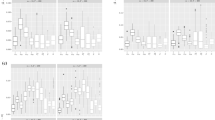Abstract
In this paper we propose a generalization of the Shapiro and Botha (1991) approach that allows one to obtain flexible spatio-temporal stationary variogram models. It is shown that if the weighted least squares criterion is chosen, the fitting of such models to pilot estimations of the variogram can be easily carried out by solving a quadratic programming problem. The work also includes an application to real data and a simulation study in order to illustrate the performance of the proposed space-time dependency modeling.
Similar content being viewed by others
References
Abramowitz M. and Stegun I.A. 1965. Handbook of Mathematical Functions. Dover, New York.
Bochner S. 1959. Lectures on Fourier Integrals. Princeton University Press, New Jersey.
Cressie N. 1985. Fitting variogram models by weighted least squares. Mathematical Geology 17: 563–586.
Cressie N. 1993. Statistics for Spatial Data (rev. ed.). Wiley, New York.
Cressie N. and Huang H.-L. 1999. Classes of non-separable, spatiotemporal stationary covariance functions. JASA 94: 1330–1340.
Dubrule O. 1983. Cross validation of kriging in a unique neighborhood. Mathematical Geology 15: 687–699.
Guttorp P., Sampson P.D., and Newman K. 1992. Non-parametric estimation of spatial covariance with application to monitoring network evaluation. Statistics in the Environmental and Earth Sciences. Edward Arnold, London, pp. 39–51.
Haas T.C. 1995. Local prediction of a spatio-temporal process with an application to wet sulphate deposition. JASA 90: 1189–1199.
Jones R.H. and Zhang Y. 1997. Models for continuous stationary space-time processes. Modeling Longitudinal and Spatially Correlated Data. Lecture Notes in Statistics 122. Springer, New York, pp. 289–298.
Journel A.G. 1986. Geostatistics: Models and tools for the earth sciences. Mathematical Geology 18: 119–140.
Journel A.G. and Huijbregts C.J. 1978. Mining Geostatistics. Academic Press, London.
Kyriakidis P. and Journel A. 1999. Geostatistical space-time models: A review. Mathematical Geology 31: 651–684.
Shapiro A. and Botha J.D. 1991. Variogram fitting with a general class of conditionally non-negative definite functions. Computational Statistics and Data Analysis 11: 87–96.
Stein M. 1999. Interpolation of Spatial Data: Some Theory for Kriging. Springer, New York.
Author information
Authors and Affiliations
Rights and permissions
About this article
Cite this article
Fernández-Casal, R., González-Manteiga, W. & Febrero-Bande, M. Flexible spatio-temporal stationary variogram models. Statistics and Computing 13, 127–136 (2003). https://doi.org/10.1023/A:1023204525046
Issue Date:
DOI: https://doi.org/10.1023/A:1023204525046




